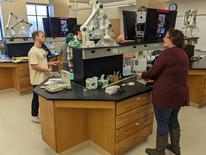
The COVID-19 pandemic showed us that education as we know it can change overnight. Even though many things have almost completely returned to their pre-pandemic state, University of Minnesota Morris Chemistry Professor Jenn Goodnough continues to embrace the technology that changed, and improved, her chemistry lab over the past two years.
The blended lab, which provides a combination of live, in-person instruction along with pre-recorded videos and online learning modules, was the result of funding from the Learning Network of Minnesota (LNM).
The LNM is a legislatively-funded telecommunications network infrastructure that connects college campuses, system offices, regional learning centers, Tribal learning centers, research centers, and extension offices. UMN Morris is one of approximately 60 campuses and higher education centers linked across the state.
Goodnough demonstrated the technology in the general chemistry lab during a Zoom call with other LNM members. “We believe we might have the only college chemistry lab in Minnesota that has this.”
The room has been equipped with ceiling-mounted cameras and microphones, and uses Solstice pods and Zoom room applications. Each of the 12 workstations is set up with a laptop and a smart TV, which are connected to the system. The instructor and students can also access the system with their own device. Goodnough stressed that even though it sounds very complicated, the technology is easy to use.
Information Technology Director Bill Zimmerman and Support Specialist Lawrence Godwin worked with then-Assistant Chemistry Professor Kara Nell to develop the blended lab. Godwin’s goal was to make a space that would allow students to be anywhere in the lab and still see and hear and social distance. “That was during the harder parts of COVID. But now, because our students are very involved in extracurricular activities, there have been many times when this is useful.”
Goodnough agreed that the usefulness has far exceeded the needs during COVID. She shared that the Cougar softball team had reviewed the pre-lab notes while on the team bus traveling to a game. The set-up also allowed Goodnough to live stream athletic events during the lab so the other students could watch their friends’ competition while working.
Goodnough was excited to show off the technology, which she says has changed the way she teaches. “I’ve totally gotten rid of lab manuals, they are now available in Canvas. Also, I no longer have to write out the pre-lab notes on the whiteboard. Instead, everything is happening on the video screens at each station.”

Goodnough can also answer in-lab questions about calculations by writing notes on her iPad and sharing the room's smart TVs. The notes can then be added to Canvas after the lab is completed. The system allows students to pause on a particular part, or to go back to something they missed. Students can also share notes over the system.
Goodnough noted that this has also been beneficial for students who require accommodations for either a physical or learning disability. For instance, they can have captioning turned on in Zoom, or can access the written descriptions for each step of the lesson.
LNM Executive Director Kim Briske is hopeful the demonstration will encourage other institutions to look at installing technology that enables secure, engaging, equitable experiences and allows learning to continue in many different situations—from pandemic responses to weather emergencies. “All the technology in the world is useless without great faculty using it for improved teaching and learning. By having a demonstration of how the equipment is supporting improved in-person and hybrid learning, other institutions can get a sense of the capabilities of the technology and ideate on future technology implementations to meet teaching and learning needs throughout the state.”